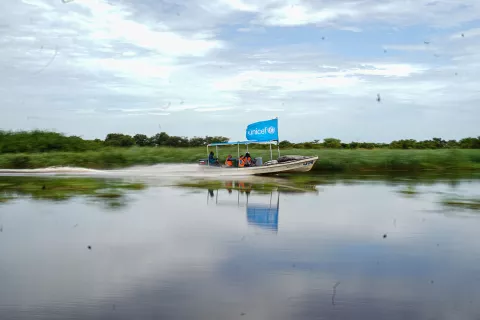UNICEF backpacks: An iconic symbol of hope and childhood aspirations
In 2021, UNICEF shipped nearly 1.3 million cyan blue backpacks to Africa, Central Asia and Latin America as part of its support to children’s learning all around the world.

At the start of 2021 in many countries, COVID-19 lockdown restrictions kept classroom doors firmly shut. By September, UNICEF estimated that children worldwide had already lost 1.8 trillion hours of in-person learning.
In the course of the year, UNICEF provided essential supplies needed to allow governments and education authorities to re-open schools safely. The provision of thermometers and personal protective equipment (PPE) meant that children could be screened and mask policies enforced. With UNICEF’s support, handwashing facilities were installed or refurbished and supplies of hand sanitizer, soap, and disinfectant distributed.
In many countries, the sight of children carrying their precious books and school supplies in a blue UNICEF backpack has come to symbolize the start of a new academic year. In 2021, UNICEF shipped nearly 1.3 million cyan blue backpacks to Africa, Central Asia and Latin America as part of its support to children’s learning all around the world.
In countries experiencing emergencies, the bags are a tangible reminder of every child’s right to education. For children and young people who have lost everything due to conflict or other disasters, receiving an individual backpack reaffirms that each child matters and that their learning will always be important.
Yemen: Ensuring children can learn amid conflict
The brutal conflict in Yemen is now seven years old, meaning that children entering the first years of school have never known a day of peace.
In 2021, 70 per cent of the population – 20.7 million people – needed humanitarian assistance while nearly 4 million, including 2 million children, were internally displaced.
By October 2020, schools across Yemen had emerged from the pandemic, and in-person learning resumed. However, close to 3,000 schools had already been destroyed, damaged, or occupied – and were no longer fit for purpose.
To help address the situation, UNICEF created a customized school bag kit, specially designed for children in Yemen. Introduced in 2018 in consultation with Yemeni education authorities, the kit consists of a backpack filled with pens, pencils, exercise books and other essential stationery supplies.

An incentive to continue learning
The school bag kit is given to children whose families are most affected by the economic consequences resulting from the humanitarian crisis in the country. For parents who cannot afford to buy school supplies, the school bag kit is an incentive to support their children to continue learning.
The kit is particularly important for children who have lost everything as a result of being displaced from their homes. The kit allows them to continue to attend school either in host communities or in safe spaces for learning and play that have been set up in camp settings.
During 2021, UNICEF Yemen provided individual learning materials to over 220,000 children, 43 per cent of them girls. This was achieved despite disruptions to the international movement of goods and a severe shortage of shipping containers.
Security issues compounded the situation, frequently hindering the movement of supplies from ports on the Gulf of Aden to the capital city of Sana’a and other destinations. Coping with these ongoing logistical issues required a mix of caution and agility – and always having a Plan B ready just in case. In 2021, UNICEF’s flexibility and coordination with government and implementing partners helped provide 720,000 children with access to formal and non-formal education, including early learning.




